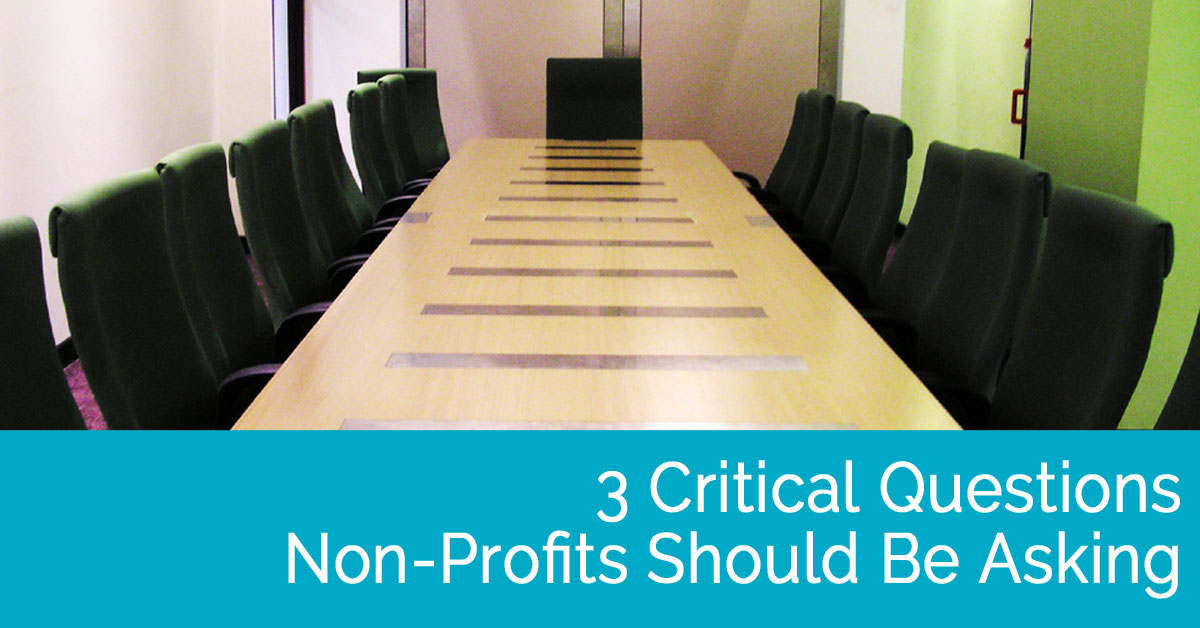
For the greatest chances of success in the organization, a Non-Profit Board of Directors (BOD) needs to be able to clearly answer these 3 critical questions:
- What outcomes is the BOD directing the non-profit organization towards?
- By what means is the organization to achieve these outcomes?
- At what cost?
The answers to these questions are critical because they set the tone for all of the activities of the organization, including the decisions the BOD makes within its governance role. Yet it is common for BOD members to not be able to clearly articulate answers for these questions…or for the BOD members to each have different answers.
Exploring the answers to these questions and making these questions and answers part of the orientation for new BOD members is a simple and easy strategy for helping to close the gap between potential and results within the BOD and in turn, within the organization.
Let’s look at these questions together.
Exploring the 3 Critical Questions for Non-Profits
What Outcomes is the Non-Profit being Directed Towards?
What are the goals or outcomes of the organization? Often, a BOD holds a day long retreat to set its strategic goals, vision, or desired outcomes. In the ideal, the BOD has involved lots of other people in the retreat to establish the desired outcomes including staff, their clients/customers, volunteers, and members of the greater community who are concerned and willing to help the organization along. This inclusive approach provides more data and a greater resource for processing what is known and what is projected. The desired outcomes are generated from the combination of the diverse viewpoints.
I browsed websites of some well known Non-Profit organizations and was surprised at how few had a clear statement of the outcomes the organization was to achieve. A good example of clear outcomes was on the site of the American Red Cross bio-medical services. They clearly aim at fulfilling the needs of the nation’s blood supply, with the safest, most reliable blood, in a cost-effective way. ‘Fulfilling the needs of the nation’s blood supply’ is a very different more decisive and measurable outcome than ‘supplying the nation’s blood supply’.
By What Means is the Non-Profit to Achieve These Outcomes?
The BOD also provides direction for the means by which the Non-Profit is to achieve the outcomes. The BOD may be clear on the means by which:
- finances and fundraising are done
- services are carried out
- risk management is achieved
- public relations is carried out
- etc.
The means is very much the strategies for ‘how’. A BOD can choose to confer the authority of the means to accomplish the outcomes to the staff. Every BOD makes the choices that are best suited to it, its community, and what it wants to accomplish.
Going back to the Red Cross website to search for evidence of the BOD direction about means, one statement stood out above all others ‘to empower ordinary people to perform extraordinary acts of service’. (source http://www.redcrossblood.org/about-us/our-mission ). While other statements of the means to accomplish the outcomes were harder to find on the website, I was able to pick up a few of them. One is to test for infectious diseases. Another is to contribute to clinical trials for blood safety. And yet another is to rely heavily on volunteers. How detailed is a BOD in determining the means for accomplishing the outcomes? It is entirely up to the BOD. In the example of the Red Cross, the BOD could simply make it clear to rely heavily on volunteers, or it could get more specific on how the volunteers are to be found, engaged, treated, and rated for performance.
At What Cost?
One of the reasons I chose to use the Red Cross blood services example is that I assume the BOD must have an extraordinarily difficult job to determine the answer to ‘At What Cost?’. The nation relies on the supply of blood. The BOD has said clearly ‘in a cost-effective way’ and yet beyond the approved budget, in a dire emergency of unanticipated magnitude, what would the BOD choose as its answer to ‘At What Cost?’. Although it doesn’t say so on the website, I would assume that its outcome of fulfilling the blood supply for the nation, despite the means to be ‘cost-effective’ and rely heavily on volunteers, it would not hold back on cost to achieve its outcome of providing the blood…and it would make every effort to garner sufficient financial donations to support what needed to be supported.
Impacts of These Questions in Non-Profits
The final choices and product of each of these questions is the business of the BOD. It is the BOD that is held accountable for the performance of the organization. With accountability comes the authority to be the final authors of the outcomes.
As the organization works towards the envisioned outcomes, the BOD and all staff must be able to justify any decision against the answers to these questions. When choosing business activities, it should be clear how the activity moves the organization closer to its desired outcomes; by which means the activities will be done; and at what cost. If it is not clear, then there is the opportunity for further discernment and perhaps to choose another strategy.
If you are a Board member of a Non-Profit, or care deeply about a Non-Profit organization, I hope that you will take these three fundamental questions back as framing questions for important conversations.
How can working with these 3 critical questions be valuable to the organization you are involved with? Share your insights in a comment below.
Photo Credit: Michelle Ho | FreeImages.com








Leave a Reply
You must be logged in to post a comment.